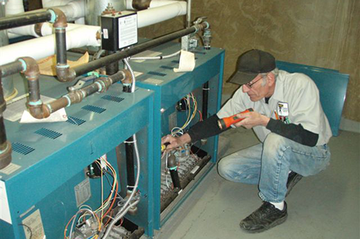
A crude “pot” where a fire warms a to some extent filled water holder from underneath. eighteenth-century Haycock boilers for the most part created and put away enormous volumes of extremely low-pressure boiler servicing coventry steam, frequently barely over that of the air. These could consume wood or most frequently, coal. Productivity was extremely low.
Fire-tube evaporator
Here, water to some extent fills a heater barrel with a little volume passed on above to oblige the steam (steam space). This is the sort of heater utilized in virtually all steam trains. The intensity source is inside a heater or firebox that must be kept for all time encompassed by the water to keep up with the temperature of the warming surface underneath the limit. The heater can be arranged toward one side of a fire tube which protracts the way of the hot gases, in this manner enlarging the warming surface which can be additionally expanded by making the gases switch heading through a subsequent equal cylinder or a heap of numerous cylinders; on the other hand, the gases might be brought the sides and afterward underneath the evaporator through pipes.

On account of a train-type kettle, an evaporator barrel stretches out from the firebox and the hot gases go through a heap of fire tubes inside the barrel which incredibly builds the warming surface contrasted with a solitary cylinder and further develops heat move. Fire-tube boilers typically have a relatively low pace of steam creation, but however high steam stockpiling limit. Fire-tube boilers for the most part consume strong powers however are promptly versatile to those of the fluid or gas assortment. Fire-tube boilers may likewise be alluded to as “scotch-marine” or “marine” type boilers.
Water-tube heater
In this kind, tubes loaded up with water are organized inside a heater in various potential designs. Frequently the water tubes associate with huge drums, the lower ones containing water and the upper ones steam and water; in different cases, for example, in a mono-tube heater, water is flowed by a siphon through a progression of loops. This type by and large gives high steam creation rates, yet less capacity limit than the abovementioned. Water tube boilers can be intended to take advantage of any intensity source and are for the most part liked in high-pressure applications since the high-pressure water/steam is held inside little breadth pipes which can endure the strain with a more slender wall. These boilers are generally developed set up, generally square in shape, and can be various stories tall.
Streak evaporator
A glimmer heater is a specific kind of water-tube evaporator in which cylinders are near one another and water is siphoned through them. A glimmer evaporator contrasts with the sort of mono-tube steam generator in which the cylinder is forever loaded up with water. Instantly heater, the cylinder is kept hot to such an extent that the water feed is immediately streaked into steam and superheated. Streak boilers had a few uses in cars in the nineteenth 100 years and this utilization went on into the mid-twentieth 100 years.
Security
- All things considered, boilers were a wellspring of numerous serious wounds and property obliteration because of inadequately grasped designing standards. Meager and fragile metal shells can burst, while ineffectively welded or bolted creases could open up, prompting a rough ejection of the compressed steam. At the point when water is changed over completely to steam, it grows to more than 1,000 times its unique volume and goes down steam pipes at the north of 100 kilometers each hour (62 mph).
- Along these lines, steam is a productive strategy for moving energy and intensity around a site from a focal kettle house to where it is required, yet without the right heater feedwater therapy, a steam-raising plant will experience the ill effects of scale development and erosion. In the best-case scenario, this increments energy costs and can prompt low-quality steam, decreased productivity, more limited vegetation, and untrustworthy activity.
- To say the least, it can prompt horrendous disappointment and a death toll. Imploded or ousted evaporator cylinders can likewise shower burning hot steam and smoke out of the air admission and terminating chute, harming the firefighters who load the coal into the fire chamber. Very enormous boilers giving many pulls to work production lines might possibly obliterate whole structures.
